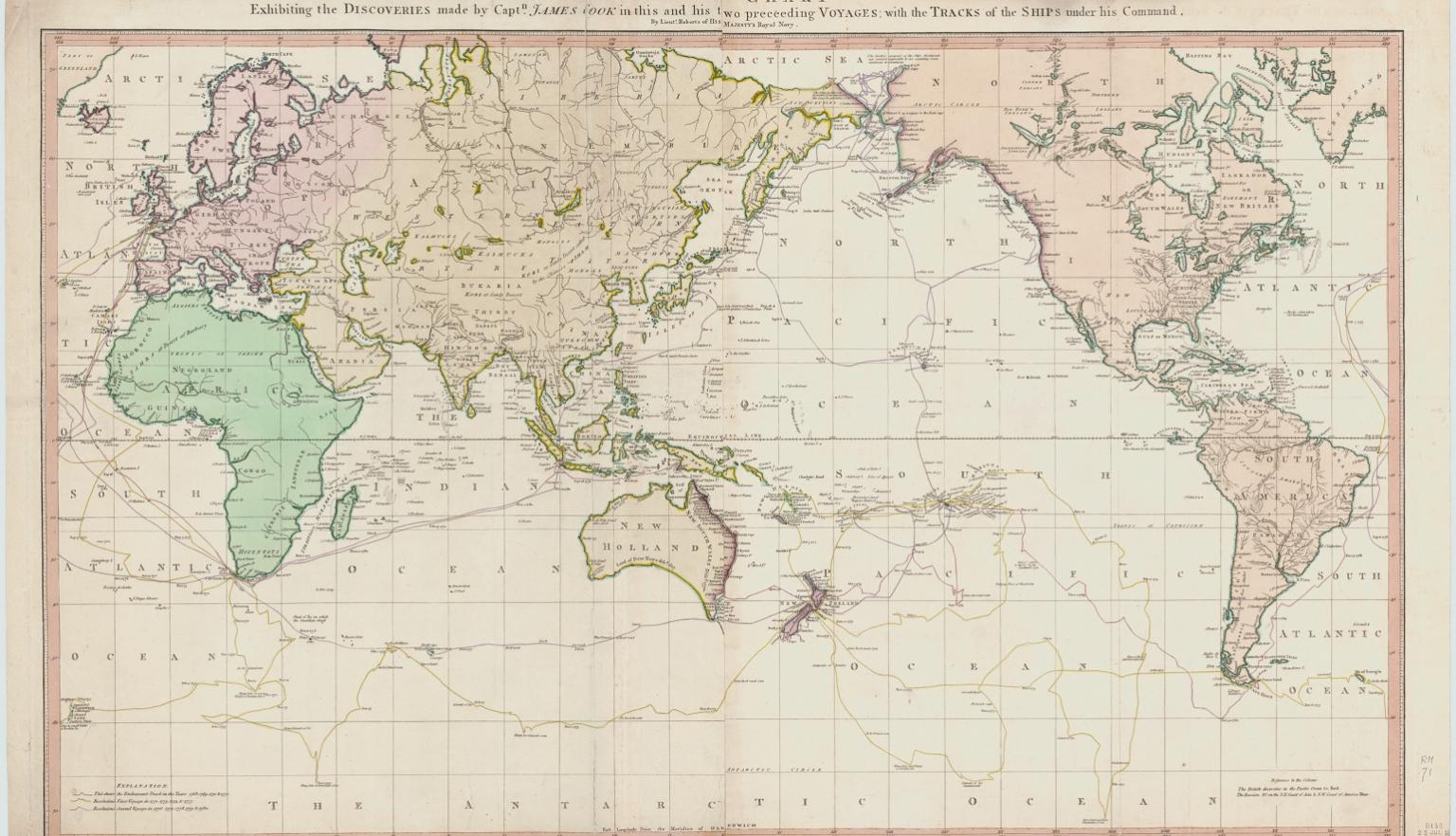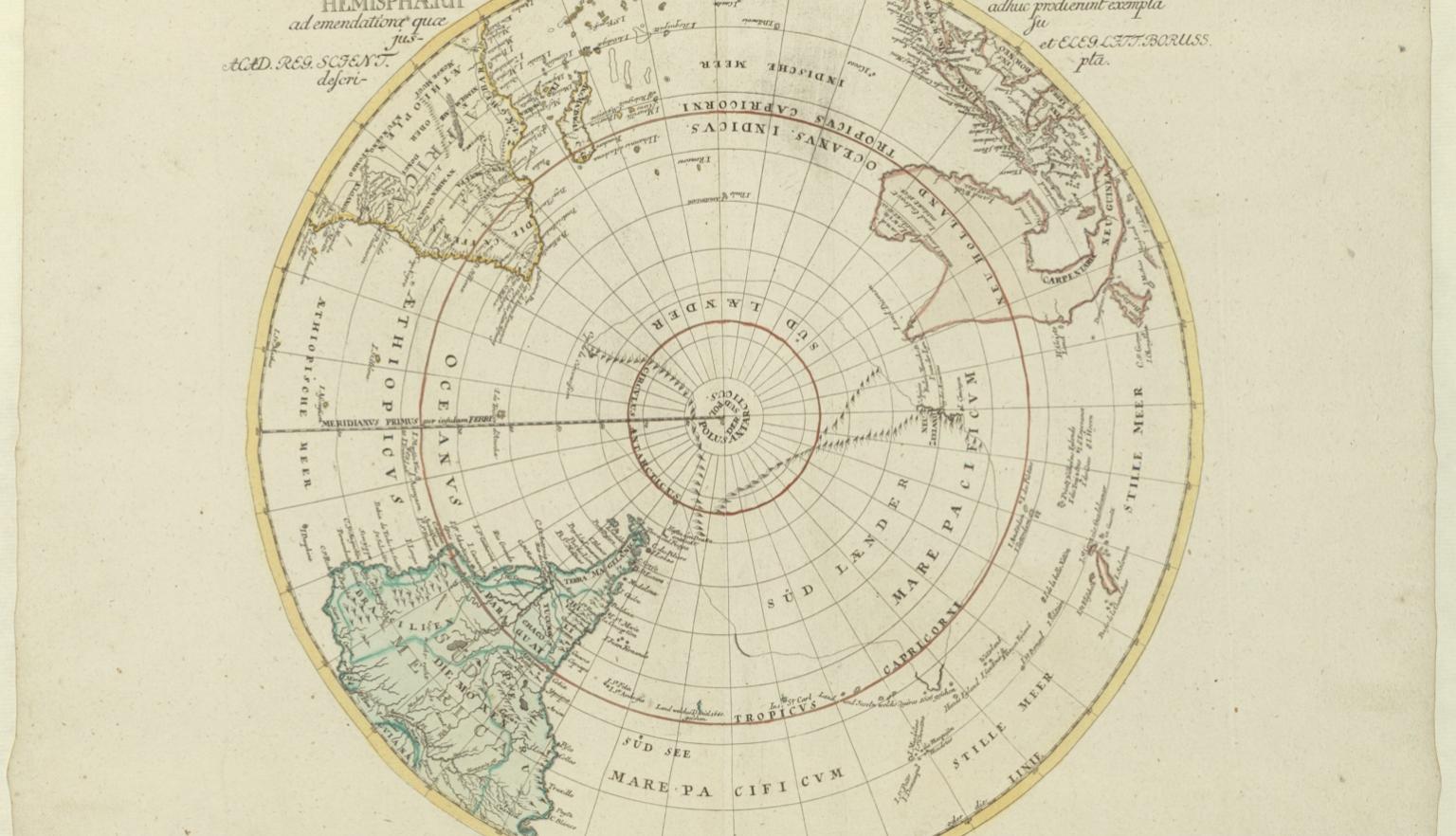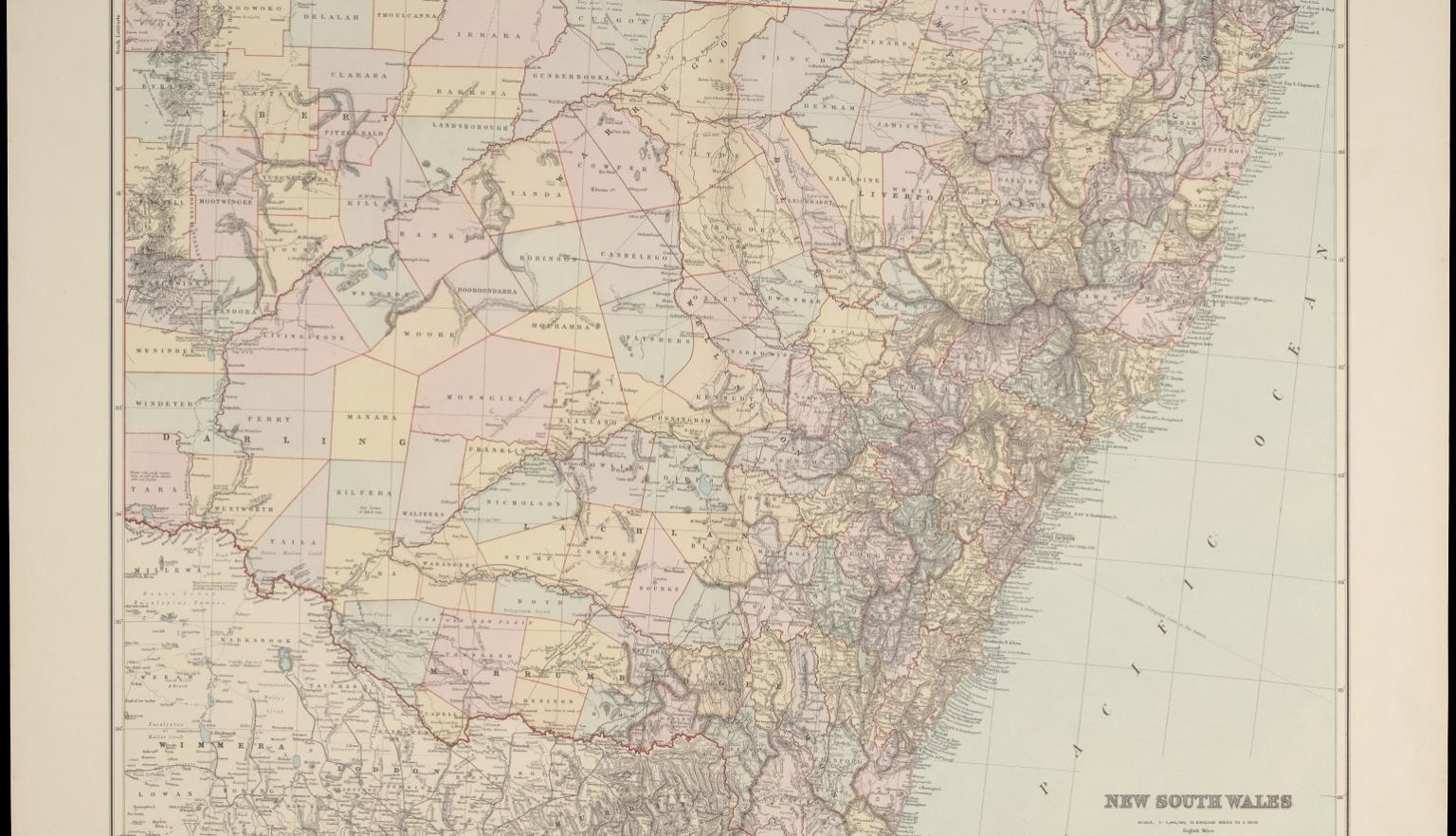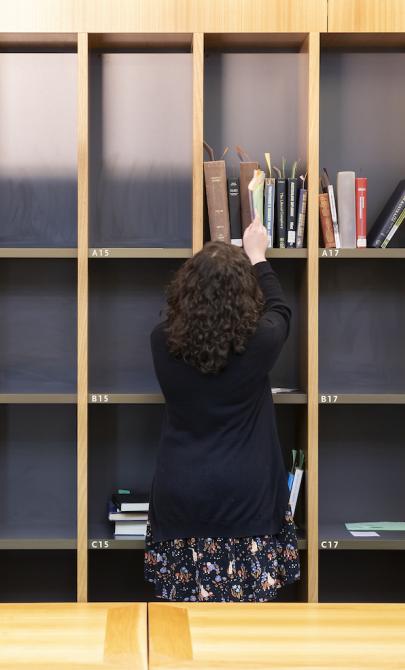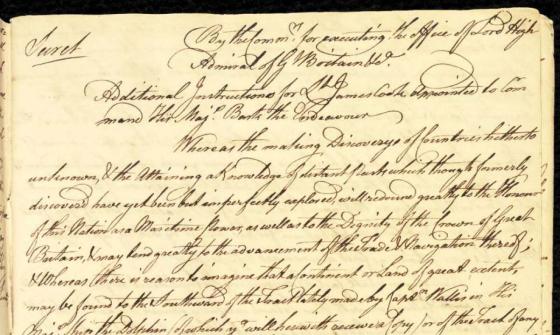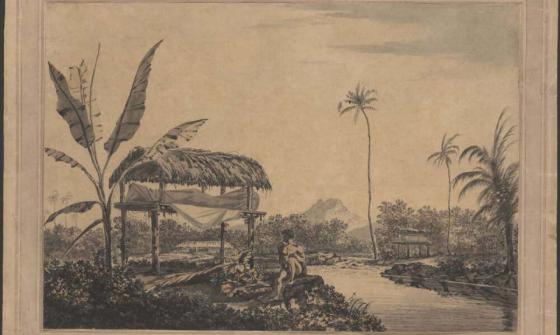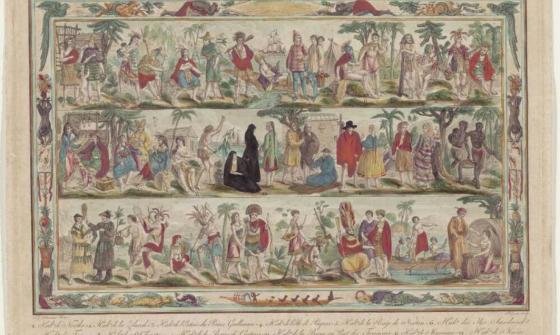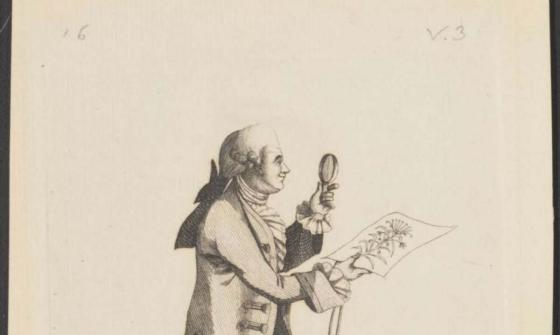James Cook and his voyages
Collection highlights
Key items in the collection
This collection hosts a range of formats, including:
The Endeavour journal of James Cook
Acquired in 1923, it has been featured in many exhibitions. In 2001, it was the first Australian item added to UNESCO's Memory of the World Register. While other first voyage journals are partly in Cook's hand, MS 1 is the only one entirely written by Cook, covering the entire Endeavour voyage. Early entries from 1768, as the ship crossed the Atlantic, are brief, but detailed passages describe Cook's experiences in Tahiti, New Zealand, and New South Wales in 1769-70. The journal is 753 pages long and was originally a series of paper volumes and loose sheets, later bound into a single volume in the late 19th century. Its current oak and pigskin binding dates from 1976.
The Endeavour letterbook 1768-71
The Endeavour letterbook, in the hand of Cook's clerk, Richard Orton, contains copies of Cook's correspondence with the Admiralty and the various branches of the Navy Board. Of particular importance are the original and additional secret instructions that he received from the Lords of the Admiralty in July 1768.
Log of H.M.S. Endeavour, 1768-1770
The other item is a log of the voyage, ending with the arrival in Batavia. The writer is not known, although it may have been Charles Green, the astronomer.
Papers of Joseph Banks 1745-1923
Other documents concerning the voyage are among the papers of Joseph Banks including his letters to the Viceroy of Brazil in 1768 and the 'Hints' of the Earl of Morton, the president of the Royal Society.
Journal of H.M.S. Resolution, 1772-1775
The Library holds a facsimile copy of the journal of HMS Resolution on the second voyage, the original of which is in the National Maritime Museum in London. It is in the hand of Cook's clerk, William Dawson.
We also hold the journal James Burney, a midshipman on HMS Adventure, covering the first part of the voyage in 1772–73. It includes a map of eastern Van Diemen's Land and Burney's transcription of Tongan music.
Letterbook of the Resolution 1771-1778
We hold the letterbook for both the second and third voyages.
Documents of the third voyage and death of Cook 1779
Documents of the third voyage include an account of the death of Cook, probably dictated by Burney.
Alexander Home Journals, 1777-1779
Two manuscripts of Alexander Home. They contain descriptions of Tahiti and Kamtschatka and another account of Cook's death.
Description of the sea coast of Nova Scotia, 1762
The earliest manuscript of Cook in the collection is his description of the coast of Nova Scotia, with two maps of Harbour Grace and Carbonere, dating from 1762.
Original family letters of Cook 1776-1926
The Library holds original letters of Cook written to John Harrison, George Perry, Sir Philip Stephens and the Commissioners of Victualling. There is also in the Nan Kivell Collection a group of papers and letters of the Cook family, 1776–1926.
Manuscript maps
The only manuscript maps drawn by Cook held in the Library are the 2 maps of Halifax Harbour, Nova Scotia, contained in MS 5. The map by James Burney of Van Diemen’s Land, contained in his 1773–74 journal, is the only manuscript map in the Library emanating from Cook’s three Pacific voyages.
First voyage maps (1773 and 1774)
On the first voyage most of the surveys were carried out by Cook himself, assisted by Robert Molyneux, the master, and Richard Pickersgill, the master’s mate. Cook produced some of the fair charts, but it seems that most were drawn by Isaac Smith, one of the midshipmen. After the voyage the larger charts were engraved by William Whitchurch and a number of engravers worked on the smaller maps. The Library holds nine maps (six sheets) and five coastal views (one sheet) published in 1773, as well as two French maps of New Zealand and New South Wales based on Cook’s discoveries (1774).
Second voyage maps (1777)
Cook and Pickersgill, who had been promoted to lieutenant, carried out most of the surveys on the second voyage. Others were performed by Joseph Gilbert, master of the Resolution, Peter Fannin, master of the Adventure, the astronomer William Wales and James Burney. Isaac Smith, the master’s mate, again drew most of the fair charts of the voyage and William Whitchurch again did most of the engravings. The Library holds 15 maps (10 sheets) published in 1777.
Third voyage maps (1784 – 1786)
On the third voyage, Cook seems to have produced very few charts. Most of the surveys were carried out by William Bligh, master of the Resolution, and Thomas Edgar, master of the Discovery. Henry Roberts, the master’s mate and a competent artist, made the fair charts and after the voyage he drew the compilation charts from which the engraved plates were produced. Alexander Dalrymple supervised the engravings. The Library holds five maps and five coastal views published in 1784–86.
Many records relating to the voyages of Cook have been microfilmed at the National Archives (formerly the Public Record Office) in London and other archives and libraries in Britain. They include the official log of HMS Endeavour and the private journals kept by Cook on his second and third voyages. The reels with the prefixes PRO or M were filmed by the Australian Joint Copying Project.
Letters
- Letters of Capt. James Cook to the Admiralty, 1768–79
- Letters of David Samwell, 1773–82 (Liverpool City Libraries)
- Correspondence of Sir Joseph Banks, 1768–1819 (Natural History Museum)
- Letters of Capt. James Cook, 1775–77 (National Maritime Museum)
Logbooks
Admiralty and Secretariat logbooks, 1737-1971
- HMS Adventure, 1772–74
- HMS Resolution, 1772–75
- HMS Discovery, 1776–79
- HMS Resolution, 1779
- HMS Resolution, 1771–80
- HMS Discovery, 1776–79
- HMS Endeavour, 1768–71
- HMS Resolution, 1771–79
- Log of Lieut. Charles Clerke on HMS Resolution, 1772–75
Observations
Discovery of methods of measuring longitude at sea
- HMS Adventure, 1772–74
- HMS Resolution, 1772–75
- Journal of Capt. J. Cook: observations on variations in compass and chronometer rates, 1776
- Astronomical observations, HMS Resolution, 1778–80
Ship’s musters
Royal Navy Ships’ musters series
- HMS Endeavour, 1768–71
- HMS Adventure, 1769–74
- HMS Resolution, 1771–75
- HMS Discovery, 1776–80
- HMS Resolution, 1776–80
Journals
- Journal of Capt. Tobias Furneaux on HMS Adventure, 1772–74 (British Library)
- Journal of Lieut. James Burney on HMS Discovery, 1776–79 (British Library)
- Journal of Thomas Edgar on HMS Discovery, 1776–79
- Drawings of William Hodges on voyage of HMS Resolution, 1772–74 (British Library)
Journals of Capt. James Cook on HMS Resolution
- HMS Resolution, 1771–74 (British Library)
- HMS Resolution, 1776–79 (British Library)
Journals of Capt. James Cook on HMS Resolution
- HMS Resolution, 1771–74 (British Library)
- HMS Resolution, 1776–79 (British Library)
- HMS Resolution and Discovery, 1776–79 (British Library)
Not-digitised
- Drafts of Capt. James Cook’s account of his second voyage (National Maritime Museum)
- Journal of voyage of HMS Endeavour, 1768–71 (National Maritime Museum)
- Journal of voyage of HMS Resolution, 1772–75 (National Maritime Museum)
- Journal of Capt. James Cook on HMS Endeavour, 1768–70 (Mitchell Library)
Charts and drawings
Personal items
The Library holds a number of objects that allegedly belonged to Cook, including his walking stick and a mahogany and rosewood fall-front desk that was believed to have been used by Cook on one of his voyages. A spirit level owned by Alexander Hood, the master’s mate on HMS Resolution in 1772–75.
- Cook’s walking stick
- Cook’s clothes brush
- Fork used by Cook
- Mahogany fall-front bureau owned by Cook
- Compass, protractor, ruler and spirit level owned by Alexander Hood
Medals
Three of the medals issued by the Royal Society in 1784 to commemorate the achievements of Cook are held in the Library. Another medal issued in 1823 to commemorate his voyages is also held.
- Commemorative medal to celebrate the voyages of Captain James Cook (1784)
- Medal to commemorate the voyages of Captain Cook (1823)
Tapa cloth
The Library has several collections of tapa cloth, including a piece of cloth and two reed maps brought back by Alexander Hood in 1774 and a catalogue of 56 specimens of cloth collected on Cook’s three voyages (1787).
James Cook portraits
We hold a vast collection of engraved portraits of Captain James Cook, many inspired by artists like Nathaniel Dance, William Hodges, and John Webber. There are also two oil portraits by unknown artists, including a copy of Dance’s work held at the National Maritime Museum in London. A highlight is a large oil painting by John Mortimer, possibly from 1771, showing Cook alongside Daniel Solander, Joseph Banks, John Hawkesworth, and Lord Sandwich.
Endeavour voyage artists
Two artists joined Cook on the Endeavour: Alexander Buchan, who passed away in Tahiti in 1769, and Sydney Parkinson, who died in Batavia in 1771. We have a few original works attributed to Parkinson, including a watercolour of breadfruit in the Nan Kivell Collection. Additionally, we hold prints from the 1773 publications of Hawkesworth and Parkinson, featuring scenes such as a Tahitian house interior, Point Venus, Matavai Bay, Māori warriors, New Zealand landscapes, and Endeavour River.
Resolution voyage with William Hodges
William Hodges served as the artist on the Resolution from 1772 to 1775. Our collection includes 18 exceptional chalk drawings by Hodges, portraying Pacific Islanders from New Zealand, Tahiti, Tonga, and other islands. We also have an oil painting of a dodo and red parakeet, as well as watercolours of Tahiti and Point Venus. Two pen and wash drawings of the Resolution by midshipman John Elliott and various prints of Pacific Island scenes, including portraits of Omai, are also part of the collection.
John Webber and William Ellis on the later voyages
John Webber, the artist on Cook’s final voyage (1776–80), created landscapes of Tahiti, Alaska, and the Sandwich Islands. Our Library holds 19 of his watercolours and drawings, as well as oil portraits of John Gore and James King. Another talented artist, William Ellis, who was the surgeon’s mate on the Discovery, is represented by 23 watercolours and drawings of scenes in Kerguelen Island, New Zealand, and other locations. A special piece by Ellis, showing the Resolution and Discovery moored in Adventure Bay in 1777, is one of the earliest Australian artworks in our collection.
Omai: Polynesia’s first visitor to London
Omai, the first Polynesian to visit London, was the subject of many portraits, including a pencil drawing by Sir Joshua Reynolds. A pantomime about Omai, titled Omai, or a Trip Round the World, was a hit in London in 1785–86. The Library holds 17 watercolour costume designs for this pantomime, created by Philippe de Loutherbourg and based on Webber’s drawings. The designs include depictions of Omai, Tahitian royalty, and figures from Kamchatka.
Bibliography
Original accounts
- Sydney Parkinson, A journal of the voyage to the South Seas, in His Majesty's Ship, the Endeavour (1773)
- John Marra, Journal of the Resolution's Voyage, in 1772, 1773, 1774, and 1775, on Discovery to the Southern Hemisphere (1775)
- James Cook, A voyage towards the South Pole, and round the world: performed in His Majesty's Ships the Resolution and the Adventure in the years 1772,1773, 1774, and 1775 (2 vols, 1777)
- William Wales, The original astronomical observations, made in the course of a voyage towards the South Pole, and round the world (1777)
- John Rickman, Journal of Captain Cook's last voyage to the Pacific Ocean, on discovery: performed in the years 1776, 1777, 1778, and 1779 (1781)
- Heinrich Zimmermann, Heinrich Zimmermanns von Wissloch in der Pfalz, Reise um die Welt, mit Capitain Cook (1781)
- William Ellis, An authentic narrative of a voyage performed by Captain Cook and Captain Clerke, in His Majesty's ships Resolution and Discovery during the years 1776, 1777, 1778, 1779, and 1780 (2 vols, 1782)
- John Ledyard, Journal of Captain Cook's last voyage to the Pacific Ocean, and in quest of a North-West Passage Between Asia & America, performed in the years 1776, 1777, 1778 and 1779 (1783)
- James Cook and James King, A voyage to the Pacific Ocean: undertaken by Command of His Majesty, for making discoveries in the Northern Hemisphere, performed under the direction of Captains Cook, Clerke, and Gore, in the years 1776, 1777, 1778, 1779, and 1780 (4 vols, 1784)
- Anders Sparrman, Reise nach dem Vorgebirge der guten Hoffnung, den sudlischen Polarlandern und um die Welt (1784)
Modern texts
- John Cawte Beaglehole (ed.), The Endeavour journal of Joseph Banks, 1768–1771 (2 vols, 1962)
- John Cawte Beaglehole (ed.), The journals of Captain James Cook on his voyages of discovery (4 vols, 1955–74)
- Andrew David (ed.), The charts & coastal Views of Captain Cook's voyages (3 vols, 1988–97)
- Beverley Hooper (ed.), With Captain James Cook in the Antarctic and Pacific: the private journal of James Burney, Second Lieutenant on the Adventure on Cook's second voyage, 1772–1773 (1975)
- Rudiger Joppien and Bernard Smith, The art of Captain Cook's voyages (3 vols in 4, 1985–87)
- Ray Parkin, H.M. Bark Endeavour: her place in Australian history: with an account of her construction, crew and equipment and a narrative of her voyage on the East Coast of New Holland in 1770 (1997)
Biographical works and related studies
There are a huge number of books and pamphlets on the lives of Cook, Banks and their associates. The following are some of the more substantial works:
- Michael Alexander, Omai, noble savage (1977)
- John Cawte Beaglehole, The life of Captain James Cook (1974)
- Walter Besant, Captain Cook (1890)
- Geoffrey Blainey, Sea of dangers: Captain Cook and his rivals (2008)
- Hector Cameron, Sir Joseph Banks, K.B., P.R.S.: the autocrat of the philosophers (1952)
- DJ Carr, Sydney Parkinson, artist of Cook's Endeavour voyage (1983)
- Harold B Carter, Sir Joseph Banks, 1743–1820 (1988)
- Vanessa Collingridge, Captain Cook: obsession and betrayal in the New World (2002)
- Richard Connaughton, Omai, the Prince who never was (2005)
- Martin Dugard, Farther than any man: the rise and fall of Captain James Cook (2001)
- Edward Duyker, Nature's argonaut: Daniel Solander 1733–1782: naturalist and voyager with Cook and Banks (1998)
- Rupert Furneaux, Tobias Furneaux, circumnavigator (1960)
- John Gascoigne, Captain Cook: voyager between worlds (2007)
- Michael E Hoare, The tactless philosopher: Johann Reinhold Forster (1729–98) (1976)
- Richard Hough, Captain James Cook: a biography (1994)
- Andrew Kippis, The life of Captain James Cook (1788)
- Arthur Kitson, Captain James Cook, RN, FRS, the circumnavigator (1907)
- Charles Lyte, Sir Joseph Banks: 18th Century explorer, botanist and entrepreneur (1980)
- John McAleer and Nigel Rigby, Captain Cook and the Pacific: art, exploration & empire (2017)
- EH McCormick, Omai: Pacific envoy (1977)
- Frank McLynn, Captain Cook: master of the seas (2011)
- John N. Molony, Captain James Cook: claiming the Great South Land (2016)
- Peter Moore, Endeavour: the ship and the attitude that changed the world (2018)
- Rob Mundle, Cook (2013)
- Maria Nugent, Captain Cook was here (2009)
- Gananath Obeyesekere, The apotheosis of Captain Cook: European mythmaking in the Pacific (1992)
- Patrick O'Brian, Joseph Banks, a life (1987)
- Rex Rienits and Thea Rienits, The voyages of Captain Cook, 1968)
- John Robson, Captain Cook's war and peace: the Royal Navy years 1755-1768 (2009)
- Marshall Sahlins, How 'natives' think: about Captain Cook, for example (1995)
- Thomas P Saine, Georg Forster (1972)
- Edward Smith, The life of Sir Joseph Banks, president of the Royal Society (1911)
- Nicholas Thomas, Cook: The extraordinary voyages of Captain James Cook (2003)
- Alan Villiers, Captain Cook, the seamen's seaman: a study of the great discoverer (1967)
About Cook’s voyages
First voyage (1768–1771)
Cook was promoted to lieutenant and given command of the Endeavour to observe the transit of Venus and search for a southern continent. The expedition included scientists and artists led by Joseph Banks. They sailed from Plymouth to Tahiti, then to New Zealand, and along the east coast of Australia. Cook charted the coast and collected botanical specimens at Botany Bay. The voyage concluded in Batavia (Jakarta), with many crew members dying of malaria and dysentery before returning to England in 1771.
Second voyage (1772–1775)
Cook, now a captain, led the Resolution and Adventure to confirm the existence of the Great Southern Continent. The ships explored the southern Indian Ocean, New Zealand, the Pacific islands, and the Antarctic Circle, reaching 71°10’S. The Adventure returned to England after a fatal encounter with Māori in New Zealand, while the Resolution continued exploring the southern Pacific, visiting various islands before returning to England in 1775.
Third voyage (1776–1780)
Cook's final voyage aimed to find the North-West Passage. The Resolution and Discovery visited Cape Town, Kerguelen Island, Van Diemen’s Land, and New Zealand, then sailed to the Hawaiian Islands and the North American coast. They reached the Bering Strait before ice forced them to turn back. Cook was killed in Hawaii in 1779, and the expedition, led by Clerke and later Gore and King, returned to England in 1780.
Background to the collection
The earliest acquisitions by the Library of original works concerning Cook’s voyages were the papers of Sir Joseph Banks and a painting of John Webber, which were acquired from E.A. Petherick in 1909. In 1923 the Australian Government purchased at a Sotheby’s sale in London the Endeavour journal of James Cook, together with four other Cook documents that had been in the possession of the Bolckow family in Yorkshire. The manuscripts of Alexander Home were purchased from the Museum Bookstore in London in 1925, while the journal of James Burney was received with the Ferguson Collection in 1970. A facsimile copy of the journal of the Resolution in 1772–75 was presented by Queen Elizabeth II in 1954.
The 18 crayon drawings of South Sea Islanders by William Hodges were presented to the Library by the British Admiralty in 1939. They had previously been in the possession of Greenwich Hospital. The view from Point Venus by Hodges was bought at a Christie’s sale in 1979. The paintings of William Ellis were part of the Nan Kivell Collection, with the exception of the view of Adventure Bay, which was bought from Hordern House in Sydney in 1993. The painting of the death of Cook by George Carter and most of the paintings of John Webber were also acquired from Rex Nan Kivell. The painting by John Mortimer was bequeathed to the Library by Dame Merlyn Myer and was received in 1987.
The manuscripts of Cook and his associates are held in the Manuscripts Collection at various locations. They have been catalogued individually. Some of them have been microfilmed, such as the Endeavour journal (mfm G27412), the Endeavour log and letterbook (mfm G3921) and the Resolution letterbook (mfm G3758). The Endeavour journal and letterbook and the papers of Sir Joseph Banks have been digitised and are accessible on the Library’s website. The microfilms have also been catalogued individually and are accessible in the Newspaper and Microcopy Reading Room.
The paintings, drawings, prints and objects are held in the Pictures Collection, while the maps and published coastal views are held in the Maps Collection. They have been catalogued individually and many of them have been digitised.
This guide was prepared using these references:
- Peter Biskup, Captain Cook’s Endeavour Journal and Australian Libraries: A Study in Institutional One-upmanship, Australian Academic and Research Libraries, vol. 18 (3), September 1987, pp. 137–49.
- Cook & Omai: The Cult of the South Seas, National Library of Australia, Canberra, 2001.
- Greg Dening, MS 1 Cook, J. Holograph Journal, in Cochrane, Peter (ed.), Remarkable Occurrences: The National Library of Australia’s First 100 Years 1901–2001, National Library of Australia, Canberra, 2001.
- Annette Healy, The Endeavour Journal 1768–71, National Library of Australia, Canberra, 1997.
- Annette Healy, 'Charting the voyager of the Endeavour journal', National Library of Australia News, volume 7(3), December 1996, pp 9-12
- Michelle Hetherington, 'John Hamilton Mortimer and the discovery of Captain Cook', British Art Journal, volume 4 (1), 2003, pp. 69-77
